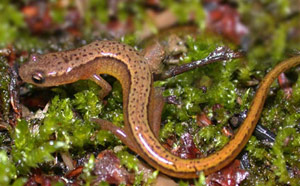CONSERVATION SECTIONS
STOKE MOUNTAINS
The Stoke Mountains massif is located approximately 5 km northeast of Sherbrooke, in the municipalities of Stoke, Ascot Corner, Dudswell and Westbury. With a surface area of approximately 193 km2, forest massifs of this size are very rare in the inhabited regions of southern Quebec.
The Stoke Mountains massif is known to support populations of the purple salamander, a species designated as vulnerable under provincial law. As part of this conservation project, Nature Eastern Townships is conducting an inventory of the streams and rivers in the Stoke Mountains to determine the location of the purple salamander populations.
66
ecological assessments covering
2,680 ha
390
new occurrences of
of northern dusky
salamander
+ 50
stream inventories
 Mainly composed of hardwood forests, the sparsely fragmented state of the Stoke Mountains massif provides it with significant potential for wildlife and plant biodiversity. The massif is marked by an extensive hydrographic system, with a minimum of 40 mapped permanent streams, providing favourable sites for stream salamanders.
Mainly composed of hardwood forests, the sparsely fragmented state of the Stoke Mountains massif provides it with significant potential for wildlife and plant biodiversity. The massif is marked by an extensive hydrographic system, with a minimum of 40 mapped permanent streams, providing favourable sites for stream salamanders.
The Stoke Mountains’ ecosystems are comprised of:
The massif’s proximity to the city of Sherbrooke, a major urban center, makes it vulnerable to urban development, which would be incompatible with maintaining the sector’s biodiversity. The conservation of the low-fragmented forest cover and multi-resource uses such as timber supply, hunting, fishing and recreational tourism is the most appropriate future vision for the rich natural capital of the Stoke Mountains. To achieve this, stakeholders must reconcile the various uses of the territory with the imperatives of conserving the natural environment.
To learn more about voluntary conservation options, click here
PROJECT PartNERS:

